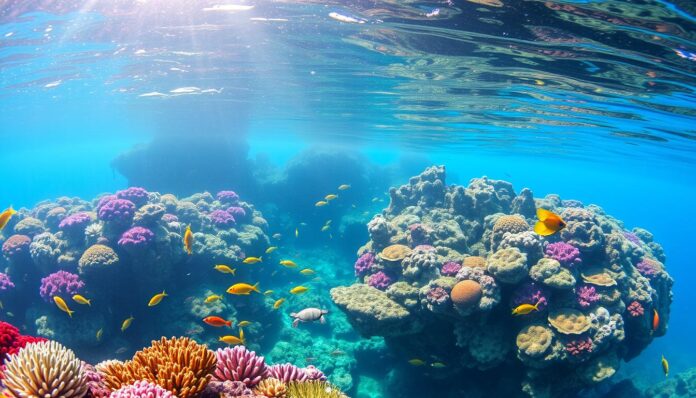| Best Time to Travel | April to October |
| What to Expect | Warm water, clear visibility, diverse marine life |
| Diving Conditions | Year-round, but best from April to October |
| Marine Life | Sea turtles, sharks, fish, coral reefs, wrecks |
Ever wondered what hidden underwater mysteries lie beneath South Korea’s coastline? Are you ready to explore a diving destination that offers an extraordinary blend of marine landscapes unlike anywhere else in the world?
Scuba diving in South Korea presents an extraordinary adventure that challenges traditional underwater exploration. With over 3000 islands and a diverse marine ecosystem, the Korean underwater landscapes offer divers an unparalleled experience. From the temperate waters of Jeju Island to the rich marine biodiversity of the East Sea, South Korea transforms underwater exploration into an epic journey.
The country’s unique geographic position creates a remarkable diving environment where cold and warm water species coexist. Divers can expect encounters with vibrant marine life, intricately formed coral reefs, and underwater terrains that tell stories of geological complexity.
Key Takeaways – Scuba Diving in South Korea
- South Korea offers year-round diving opportunities across diverse marine environments
- Over 3000 islands provide multiple diving locations with unique characteristics
- Underwater landscapes range from cold water kelp forests to tropical coral reefs
- Jeju Island remains the premier destination for scuba diving enthusiasts
- Diving expertise levels from beginner to advanced can find suitable experiences
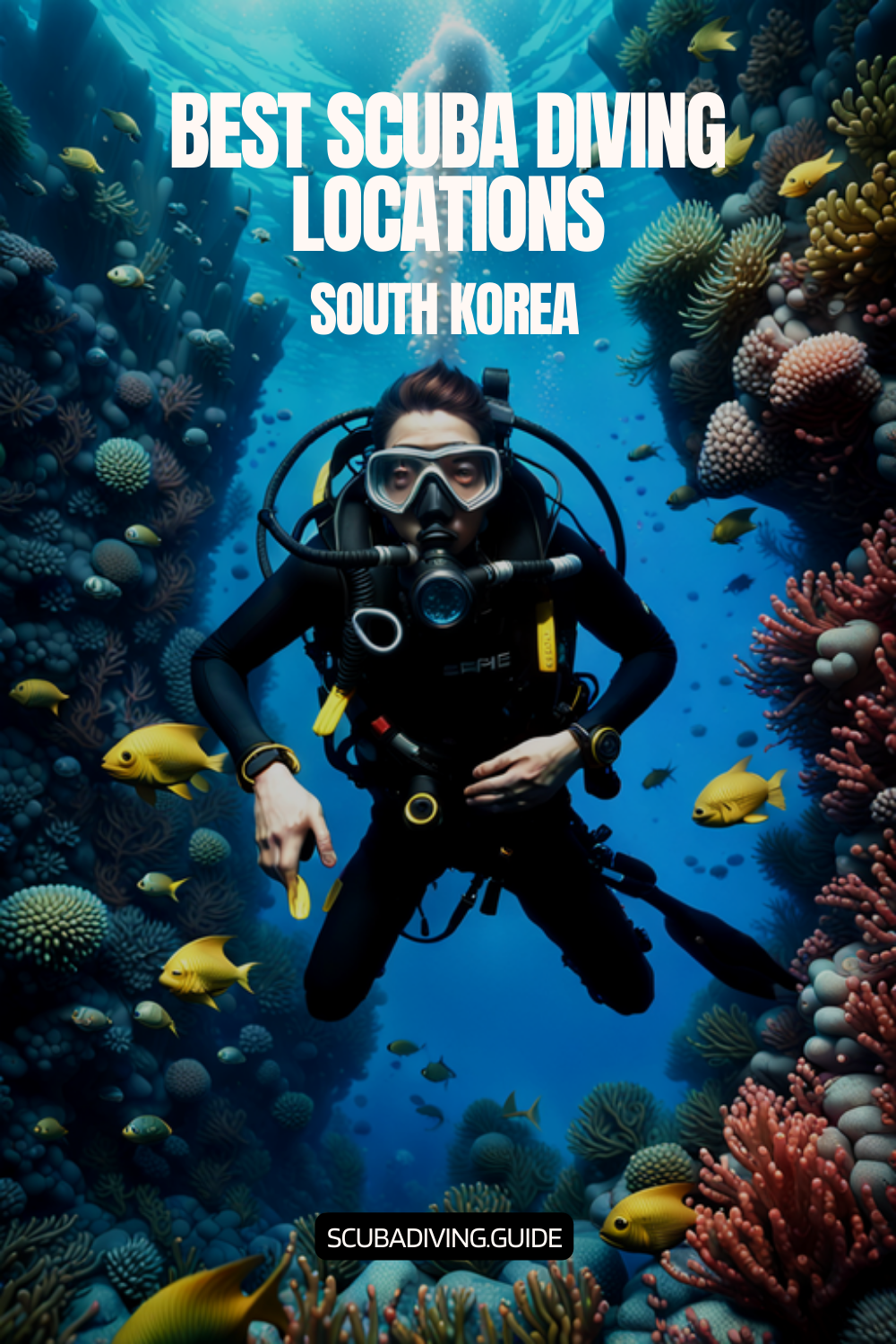
Introduction to Scuba Diving in South Korea
South Korea is a top spot for scuba diving, attracting divers from everywhere. It has over 3,000 islands and a wide range of marine life. This makes diving in South Korea a special adventure.
The underwater world in Korea is very different. You’ll find everything from cold waters in the East Sea to warm ones in the south. This variety makes diving in South Korea stand out.
Overview of the Diving Scene
Diving in South Korea is exciting and varied. You can dive in many places, each with its own unique experience:
- Temperate marine ecosystems in northern waters
- Subtropical diving environments in southern regions
- Unique marine biodiversity
- Professional diving infrastructure
What Makes South Korea Unique for Divers
Several things make diving in Korea special:
- Geographical Diversity: From cold northern waters to warm southern coasts
- Marine Ecosystem Variety: Multiple underwater environments within a single destination
- Cultural Connection: Deep maritime traditions like Haenyeo free diving
“South Korea offers an underwater world that combines natural beauty with cultural richness.” – Marine Exploration Magazine
South Korea has everything for divers. With professional centers, clear waters, and beautiful marine life, it’s becoming a top diving spot.
Best Diving Locations in South Korea
South Korea has a wide range of underwater spots for scuba lovers. With over 3,000 islands, it offers many amazing places to dive. These spots are great for all levels of divers.
Diving in South Korea is a special experience. It combines beautiful sea life with rich culture. Each spot has its own charm and challenges for divers.
Jeju Island: A Diver’s Paradise
Jeju Island is the top spot for diving in South Korea. It’s famous for its crystal-clear waters and rich marine life. Diving here is top-notch from September to November.
- Visibility ranges from 5 to 8 meters
- Water temperatures around 18°C (64.4°F)
- UNESCO-recognized Haenyeo divers indigenous to the region
“Jeju Island provides diving conditions comparable to world-renowned locations like Poor Knights in New Zealand and Gozo in Malta.”
Busan: The Coastal Gem
Busan offers great diving spots along South Korea’s southern coast. Its unique location creates many exciting underwater areas. It’s perfect for both new and seasoned divers.
Incheon: Diving Near the Capital
Incheon is great for divers near Seoul. It has diverse marine environments. Its close location to the capital is a big plus for those short on time.
Planning is key for diving in South Korea. The best time to dive is in the summer. Water temperatures then are perfect for exploring the sea.
Relevant Marine Life to Encounter
South Korea is home to a vibrant underwater world. It has a mix of cold and warm water species. This creates a unique landscape for those who explore the sea.
Divers in Korean waters will see a wide range of marine life. They’ll find everything from colorful coral reefs to complex marine habitats. These places are home to many different species.
Colorful Coral Reefs of Korea
Jeju Island is a top spot for those who love marine life. It has amazing soft coral formations in all sorts of colors. Divers can see:
- Vibrant soft coral walls
- Diverse marine ecosystems
- Unique underwater landscapes
Unique Species Native to Korean Waters
South Korea is home to fascinating native species. These creatures are a hit with underwater photographers and marine biologists.
| Region | Notable Marine Species |
|---|---|
| Jeju Island | Nudibranch, Abalones, Frogfish |
| Uljin | Various Eel Species, Shipwreck Inhabitants |
| Nam Hae | Wrasse, Starfish, Octopuses |
Divers can explore many areas, each with its own marine world. From the eastern coast to the southern islands, South Korea’s underwater world is full of amazing marine life.
South Korea’s marine ecosystems are a hidden treasure for underwater exploration. They offer rich biodiversity and unique species.
Whether you’re a professional photographer or just love adventure, diving in South Korea is unforgettable. You’ll see incredible underwater landscapes and a wide variety of species.
Ideal Diving Seasons in South Korea
Scuba diving in South Korea is a unique experience that changes with the seasons. Each time of year brings its own underwater wonders. Knowing the diving conditions helps divers plan their adventures with excitement.
The diving season in South Korea runs from June to November. Each month offers its own special charm under the sea. Local divers love the changing underwater worlds.
Spring: A Time for Marine Renewal
Spring is when marine life in Korean waters starts to buzz. Divers see:
- Marine life waking up from winter
- Soft coral starting to grow back
- Marine mating behaviors
Summer: Perfect Temperature for Diving
Summer is the best time for diving in South Korea. The water is warm, between 21ºC to 29ºC. This makes diving around Jeju and Namhae perfect.
“Summer diving in South Korea offers warm waters and vibrant marine ecosystems” – Local Diving Expert
Fall: Gorgeous Underwater Scenes
Fall is great for underwater photography. The water is clear, and the temperatures are just right. It’s a perfect time to capture stunning underwater scenes in the south.
| Season | Water Temperature | Diving Conditions |
|---|---|---|
| Summer | 21-29°C | Optimal diving conditions |
| Fall | 18-23°C | Clear waters, great visibility |
Pro tip: Consider a drysuit for diving during shoulder seasons to maximize your underwater exploration in South Korea.
Scuba Diving Certification Options
Diving fans in Korea have many paths to explore underwater. South Korea offers training for all levels, with certifications recognized worldwide. These options meet different needs and skill levels.
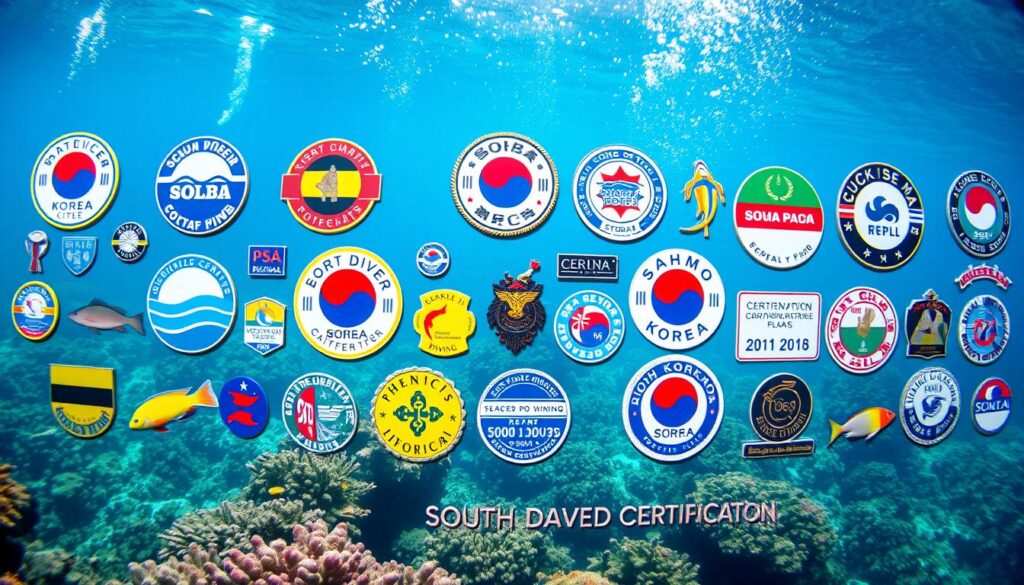
PADI vs. SSI: Choosing Your Diving Path
Two big names stand out for Dive Certifications in Korea: PADI and SSI. Each has its own benefits for divers:
- PADI certifications are known everywhere
- SSI offers flexible learning
- Both have detailed training programs
Local Dive Schools and Training Centers
South Korea has top-notch dive schools for certification. Deepstation is a leading center, with:
- Dive sessions from W44,000 on weekdays
- A 36-meter deep dive well
- Options for all diving levels
“Learning to dive in Korea opens up a world of underwater exploration and cultural adventure.”
Specialized Certification Opportunities
There’s more to Dive Certifications in Korea than basic training. Global Underwater Explorers (GUE) offers premium experiences with special features:
- Year-round GUE classes
- Staff with advanced certifications
- Initiatives for environmental conservation
With many certification paths and top facilities, South Korea is perfect for divers. It’s a great place to learn and explore amazing underwater worlds.
Essential Gear for Scuba Diving
Getting ready for an underwater adventure in South Korea means picking the right scuba gear. Scuba gear rental in Korea gives divers many choices for a safe and fun dive. The right equipment can greatly improve your diving trip.
Exploring Korean waters requires thinking about the unique conditions. Water temperatures change, so choosing the right gear is key.
Recommended Wetsuits for Korean Waters
Finding the right wetsuit is important for comfort and safety. Depending on the season, divers should choose:
- Spring (March-May): 5mm wetsuit recommended
- Summer (June-August): 3mm wetsuit ideal
- Autumn (September-November): 5mm wetsuit preferred
- Winter (December-February): 7mm wetsuit necessary
Additional Equipment for Enhanced Diving
To make your diving in Korea even better, consider these must-haves:
- Dive Light: Essential for diving in dark places
- Surface Marker Buoy (SMB): Keeps you visible and safe
- Underwater Camera: To capture the beauty of marine life
- Emergency Signaling Device: GPS-enabled for rescue
“Proper gear can transform a good dive into an extraordinary underwater experience.”
Scuba gear rental in Korea is easy to find, with prices from 50,000-100,000 KRW per day. Many dive centers offer full rental packages. These include wetsuits, masks, fins, and more.
PADI-certified divers know a lot about choosing the right gear. With over 27 million divers worldwide, they understand the value of quality equipment.
Safety Tips for Scuba Diving
Scuba diving in South Korea needs careful planning and a focus on safety. The underwater world is full of amazing sights, but you must be prepared. Knowing how to stay safe is key.
Essential Diving Health Checks
Before you start diving in South Korea, getting a health check is a must. Doctors say it’s important to make sure you’re fit for diving. This check helps ensure your safety underwater.
- Complete a diving medical questionnaire
- Obtain physician clearance for diving activities
- Check cardiovascular and respiratory health
- Verify ear and sinus condition
Importance of Dive Buddies
Having a dive buddy is vital for safe diving in South Korea. Diving with someone who knows what they’re doing can greatly lower risks. It makes your underwater adventure safer.
| Safety Aspect | Dive Buddy Benefit |
|---|---|
| Emergency Response | Immediate assistance if problems occur |
| Equipment Check | Mutual gear verification before diving |
| Navigation | Shared orientation and route tracking |
“Plan Your Dive, Dive Your Plan” – The Golden Rule of Scuba Safety
Studies show that having a dive buddy can cut down on diving accidents by about 50%. Diving in South Korea is safer when you follow important rules:
- Wait 24 hours after diving before flying
- Monitor air supply consistently
- Maintain relaxed underwater movement
- Avoid contact with marine environments
Getting proper training and certification is essential for a safe and fun diving experience in South Korea’s beautiful waters.
Diving Etiquette in South Korea
Scuba diving in South Korea is more than just knowing how to dive. It’s about respecting the sea and local traditions. Knowing how to dive right can make your experience better and help protect Korea’s oceans.
Respecting Marine Life
Exploring the sea in South Korea means following important rules to keep marine habitats safe:
- Maintain a minimum distance of 3 meters from marine creatures
- Never touch coral reefs or underwater organisms
- Avoid disturbing sea environments with excessive movement
- Practice neutral buoyancy to prevent accidental damage
Following Local Laws and Regulations
South Korea has its own rules for diving that everyone must follow:
| Regulation Category | Key Requirements |
|---|---|
| Protected Marine Areas | Restricted access during specific seasons |
| Species Protection | No hunting or collecting marine life |
| Diving Permits | Required in certain conservation zones |
“Respect the ocean, and it will respect you.” – Korean Diving Proverb
Language can be a challenge when diving in South Korea. Being prepared and talking to local dive operators is key for a responsible dive.
Scuba Diving Tours and Packages
South Korea has exciting Korea Liveaboard Trips for all divers. The diving spots are amazing, with stunning coastlines and islands.
Divers can pick from many tours to see South Korea’s marine wonders. Jeju Island is a top spot for these trips, with incredible diving.
Guided Tours: What to Expect
Professional dive guides offer great tours. They include:
- Expert local guides
- Small groups for a personal touch
- Transport to the best dive spots
- Equipment rental and safety talks
Customized Packages for Groups
Group diving packages are made for everyone. They include:
- Training for different skills
- Exploring many dive sites
- Places to stay
- Activities to learn about the culture
| Package Type | Duration | Price Range | Skill Level |
|---|---|---|---|
| Beginner Package | 2-3 Days | $250-$400 | Entry Level |
| Advanced Exploration | 4-5 Days | $500-$750 | Intermediate/Advanced |
| Jeju Island Special | 5-7 Days | $700-$1000 | All Levels |
“The beauty of South Korean diving lies not just in the underwater landscapes, but in the unique cultural experiences that accompany each journey.”
When choosing a Korea Liveaboard Trip, think about the season, marine life, and your skill level. This will make your underwater adventure unforgettable.
Cultural Insights for Divers
Scuba diving in South Korea is more than just exploring the sea. It’s a chance to dive into the local culture and traditions.
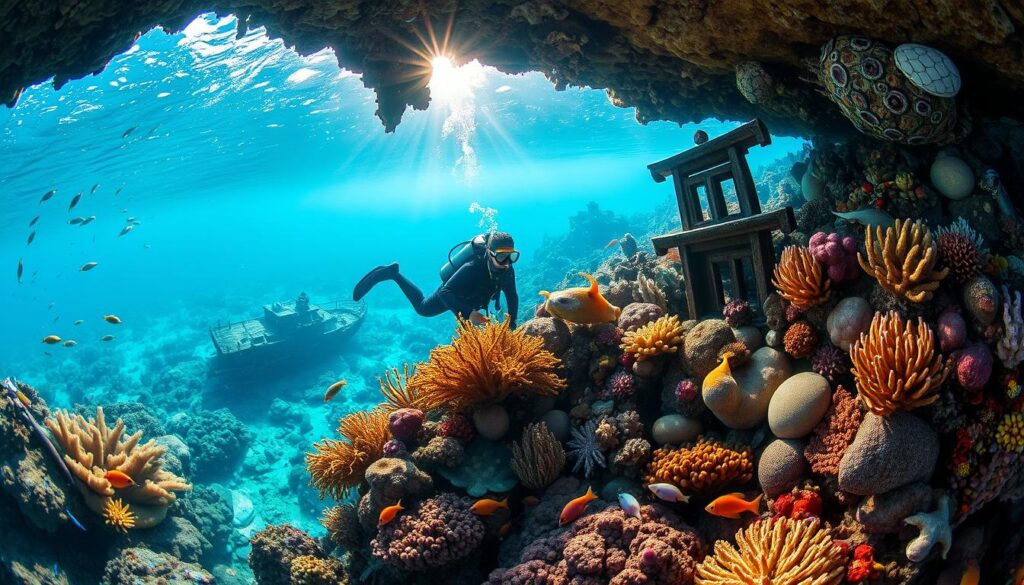
Diving in South Korea has its own special cultural touches. Knowing the local customs can make your dive better and your interactions with locals more meaningful.
Understanding Korean Diving Customs
The diving culture in Korea is rich and fascinating. It’s influenced by the Haenyeo – female divers who have been diving for seafood for centuries. They are a symbol of Korea’s cultural heritage:
- UNESCO recognized Haenyeo culture as Intangible Cultural Heritage in 2016
- Traditionally dive without modern equipment to depths of 10 meters
- Represent a semi-matriarchal community on Jeju Island
Food and Activities Post-Dive
After diving, you can try local foods. These meals are not just tasty, but also help you recover from your dive.
| Recommended Post-Dive Dishes | Benefits |
|---|---|
| Haemul Pajeon (Seafood Pancake) | High protein, rich in seafood nutrients |
| Samgyetang (Ginseng Chicken Soup) | Helps restore energy, boosts immune system |
| Doenjang Jjigae (Soybean Paste Stew) | Warm, nutritious, aids muscle recovery |
“Diving in South Korea is not just about exploring underwater landscapes, but experiencing a culture deeply connected to the sea.” – Korean Diving Expert
Scuba diving in South Korea is a journey into culture. It’s not just about the sea. It’s about the traditions, the food, and the memories you make.
Challenges for Divers in South Korea
Scuba diving in South Korea comes with its own set of challenges. Divers need to be aware of these to have a great underwater adventure.
Weather Considerations for Diving
The weather in South Korea greatly affects diving. The changing seasons bring different underwater worlds. Divers must be ready for these changes.
- Summer typhoons can disrupt diving schedules
- Winter temperatures require specialized cold-water gear
- Spring and fall offer most stable diving conditions
Navigating Challenging Currents
Diving in South Korea means understanding local currents. Places like Jeju Island and Busan have strong currents. These can be tough even for seasoned divers.
“Know the water before you enter” – Korean Diving Proverb
Visibility and Safety Strategies
Visibility changes a lot in different diving spots in Korea. Divers should expect:
- Reduced visibility during plankton blooms
- Clearer waters in late summer and early autumn
- Using advanced underwater navigation techniques
Professional preparation and local guidance are essential for safe Scuba Diving in South Korea.
Photography Tips for Underwater Exploration
Capturing the mesmerizing Korean Underwater Landscapes needs skill, practice, and the right gear. Underwater photography has its own set of challenges. It requires special techniques and knowledge.
Best Practices for Underwater Shots
Starting with underwater photography means learning a few key techniques. The first 10 meters of water have the most vibrant colors. This makes it perfect for capturing Korean Underwater Landscapes.
- Position yourself within 3-4 feet of the subject
- Use forced flash for optimal image quality
- Lock focus on stationary marine creatures
- Practice buoyancy control to minimize silt disturbance
Recommended Cameras and Equipment
Choosing the right camera can make a big difference in your underwater photography. Compact cameras like the Canon G16 are great for beginners.
| Camera Type | Recommended Use | Price Range |
|---|---|---|
| Compact Camera | Beginners | $300-$600 |
| Mirrorless Camera | Intermediate | $800-$1500 |
| Professional DSLR | Advanced Photographers | $2000-$5000 |
“Underwater photography is about patience, technique, and understanding your environment.” – Professional Marine Photographer
When exploring Korean Underwater Landscapes, always put safety first. Keep an eye on your air supply, depth, and no-decompression time. This is important for both diving and photography.
- Recommended aperture: F8 for macro shots
- Ideal depth for scenic shots: 25 feet or less
- Practice with camera housing before diving
Pro tip: Take test shots in dim light to get used to your camera settings before diving into the magical Korean Underwater Landscapes.
Environmental Conservation Efforts
Marine Life in South Korea is a delicate ecosystem that needs protection. The country has started important efforts to keep its underwater worlds safe. It knows how vital marine biodiversity is.
South Korea is serious about saving its marine life. It has launched several programs to protect and fix marine habitats.
Importance of Marine Protected Areas
Marine Protected Areas (MPAs) are key in saving South Korea’s seas. These areas do many important things:
- Keep biodiversity safe
- Protect endangered sea creatures
- Fix damaged sea habitats
- Help fishing stay sustainable
“Our oceans are not just water, they are the lifeblood of our planet.” – Marine Conservation Expert
How Divers Can Contribute
Divers in South Korea can help with conservation in many ways:
- Join underwater clean-up efforts
- Report any changes in marine life
- Support local groups working on conservation
- Follow responsible diving practices
There’s good news about marine conservation. For example, near Dokdo, managing sea urchin populations has made a big difference. The Ministry of Oceans and Fisheries releases about 10,000 young striped beakfish each year. This helps control sea urchin numbers.
Divers play a big role in protecting marine life. They help keep South Korea’s underwater wonders safe for the future.
Testimonials and Experiences from Divers
Scuba diving in South Korea is an amazing underwater adventure. It captures the hearts of divers from all over. Personal stories show the unique experiences waiting beneath the waves of this fascinating place.
Beginner Diver Perspectives
New divers in South Korea share amazing stories. They find the marine environments both challenging and inspiring. Many are surprised by the diverse marine life they see.
- Unexpected underwater volcanic formations near Jeju Island
- Encounters with rare marine species
- Challenging yet rewarding diving conditions
“My first dive in South Korean waters was like entering another world – completely different from anything I’d experienced before!” – Sarah Mitchell, PADI Open Water Diver
Experienced Divers’ Adventures
Seasoned divers offer deep insights into diving in South Korea. They share the unique challenges and rewards of exploring these waters.
| Location | Diving Highlights | Depth Range |
|---|---|---|
| Jeju Island | Volcanic underwater landscapes | 39-130 feet |
| Seogwipo | Most extensive dive area | 25-50 feet visibility |
| Yangyang | Challenging current conditions | 90 feet depth |
Divers say South Korea has a unique underwater environment. It challenges and delights explorers of all skill levels. The mix of volcanic landscapes, diverse marine life, and dynamic water conditions makes every dive unforgettable.
South Korea Recommended Scuba Diving Itinerary
Planning a scuba diving trip to South Korea? With its diverse underwater landscapes and captivating marine life, the country offers a multitude of exciting dive sites to explore. To help you make the most of your diving adventure, we’ve put together a recommended scuba diving itinerary that showcases some of the best diving locations in South Korea.
Day 1: Arrive in Seoul
Start your journey in the vibrant capital city of Seoul, where you can take some time to acclimate and immerse yourself in Korean culture. Explore the city’s historical sites, visit traditional markets, and indulge in delicious Korean cuisine. This is also an excellent opportunity to visit local diving centers to gather information, rent equipment, and arrange any necessary permits or certifications.
Day 2-3: Dive Busan
From Seoul, take a domestic flight or high-speed train to the coastal city of Busan. Busan offers a range of dive sites suitable for divers of all levels. Spend a couple of days exploring the underwater wonders of sites like Igidae, Haeundae Beach, and Gadeokdo Island. These locations boast diverse marine ecosystems, including colorful coral reefs, submerged forests, and abundant marine life. After your dives, take time to enjoy Busan’s vibrant nightlife and sample its famous seafood delicacies.
Day 4-6: Dive Jeju Island
Fly from Busan to Jeju Island, a volcanic island located off the southern coast of South Korea. Jeju Island is a paradise for divers, offering an array of captivating dive sites. Spend several days diving in sites such as Sinyang Beach, Seongsan Ilchulbong, and Marado Island. These locations are known for their crystal-clear waters, vibrant coral reefs, and unique underwater rock formations. Keep an eye out for marine life encounters, including colorful fish, sea turtles, and possibly even dolphins. Take time to explore the island’s natural beauty and iconic landmarks, such as the Jeju Olle Trail and the UNESCO-listed Jeju Volcanic Island and Lava Tubes.
Day 7-8: Dive Ulleungdo
From Jeju Island, travel to Ulleungdo, a scenic island located in the East Sea. Known for its dramatic landscapes and crystal-clear waters, Ulleungdo offers fantastic diving opportunities. Dive sites like Seonginbong and its underwater caves are particularly popular, providing a unique diving experience. Marvel at the vibrant soft coral gardens and keep an eye out for larger marine species such as groupers and rays. Above water, explore the island’s picturesque hiking trails, stunning viewpoints, and traditional villages.
Day 9-10: Dive Sokcho
From Ulleungdo, make your way to Sokcho, a charming coastal city on the northeast coast of South Korea. Sokcho is known for its stunning natural beauty and unique diving experiences. Dive sites within the Seoraksan National Park offer the perfect combination of mountainous landscapes and underwater wonders. Explore kelp forests, encounter a variety of fish species, and appreciate the region’s scenic beauty both above and below the water’s surface. While in Sokcho, take the opportunity to visit the iconic Seoraksan Mountain and enjoy fresh seafood from the local markets.
Day 11: Departure
On your final day, return to Seoul to catch your international flight or continue your exploration of South Korea’s cultural and historical sites. Reflect on the incredible diving experiences you’ve had and the memories created during your scuba diving adventure in South Korea.
It’s important to note that this itinerary can be customized based on your preferences, available time, and diving experience. Consider consulting with local diving centers and tour operators to fine-tune your itinerary and ensure a seamless and enjoyable experience.
As you embark on your scuba diving journey in South Korea, be prepared with the necessary diving certifications, appropriate equipment, and a sense of adventure. Remember to adhere to safety protocols, respect marine ecosystems, and follow local diving regulations to ensure a responsible and sustainable diving experience.
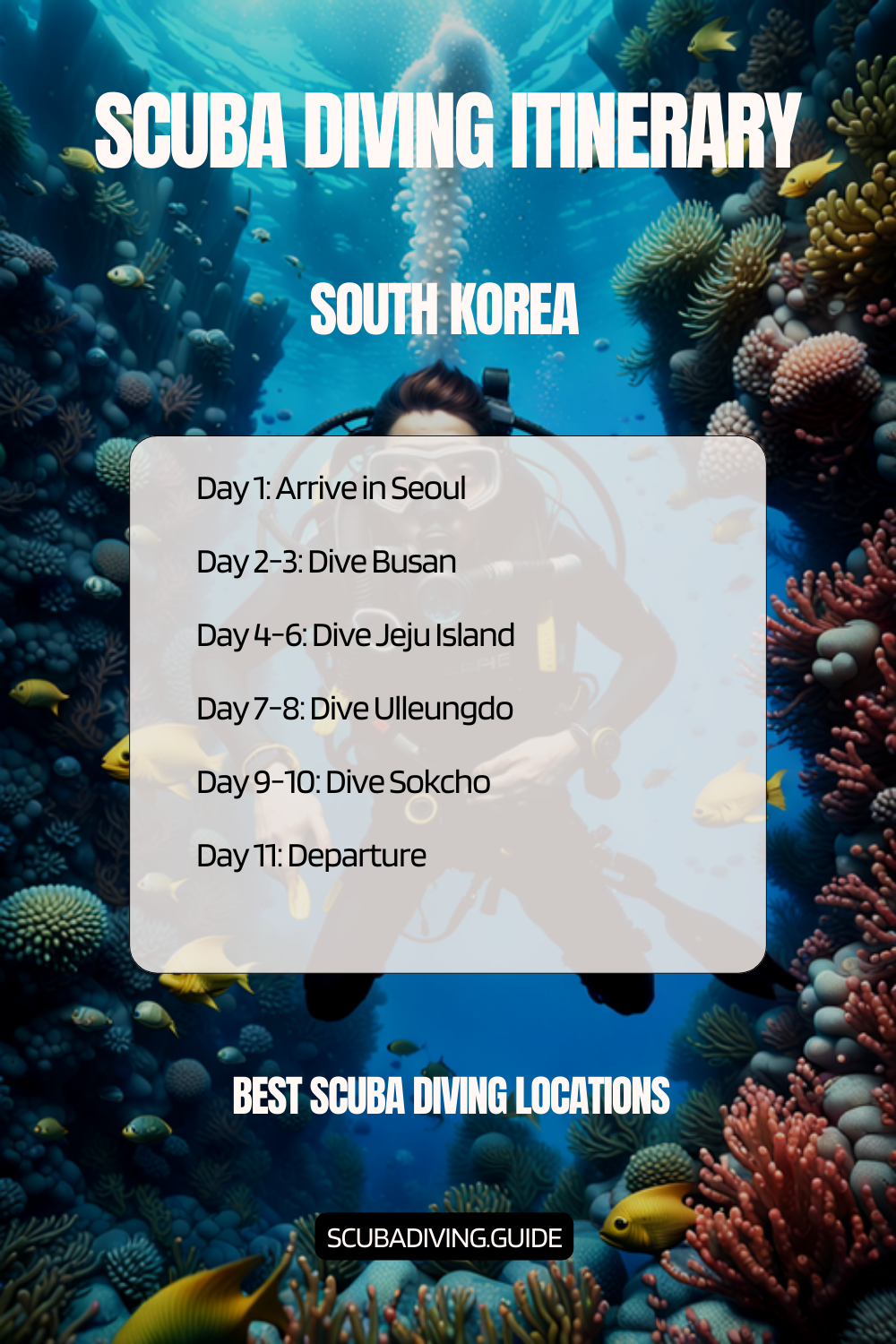
Other Countries to Consider
Conclusion: Dive into Adventure
Scuba diving in South Korea is an amazing journey. It mixes natural beauty with unique marine experiences. From Ulleungdo Island’s clear waters to diverse marine ecosystems, it offers an adventure unlike any other.
The underwater world of South Korea is full of wonders. You’ll see rocky outcrops, underwater caves, and ancient lava flow tunnels. Dive centers in places like Ulleungdo help divers of all levels explore these amazing places safely.
Embracing the Beauty of South Korea’s Waters
Divers will find a world teeming with life. You’ll see colorful fish, soft corals, and vibrant sea anemones. Scuba diving here is more than just an activity. It’s a deep connection with nature, thanks to local conservation efforts.
Getting Started with Your Diving Journey
Get ready for an underwater adventure that’s both exciting and educational. With dive sites for all skill levels and training programs, your South Korean diving adventure is waiting. Start planning, get certified, and explore the incredible marine world of this unique destination.
FAQ – Scuba Diving in South Korea
Do I need a special certification to dive in South Korea?
You don’t need a Korean certification. But, you’ll need a PADI, SSI, or similar international scuba diving certification. Dive centers in South Korea usually accept these certifications. It’s best to have at least an Open Water Diver level.
What is the best time of year to go scuba diving in South Korea?
Summer (June to August) is the best time for diving. The water is warm, and visibility is great. Fall (September to November) is also good, with clear waters and colorful underwater scenes. Water temperatures range from 10°C in winter to 25°C in summer.
How affordable is scuba diving in South Korea?
Scuba diving in South Korea is quite affordable. A single dive costs around ₩100,000-₩200,000 (about $75-$150), including equipment rental. Certification courses cost between ₩400,000-₩600,000 ($300-$450).
What marine life can I expect to see while diving in South Korea?
South Korean waters are home to diverse marine life. You can see soft coral colonies, various fish, and seasonal visitors like rays and sharks. The marine ecosystem changes from temperate to subtropical waters.
Are there any unique diving experiences in South Korea?
Jeju Island offers unique diving experiences. You can dive in clear waters and explore underwater lava tubes and vibrant coral reefs. There are also historical wreck sites to discover. The Haenyeo culture adds a special touch to diving.
What equipment should I bring for diving in South Korea?
Bring your personal mask, wetsuit, and dive computer. For cold water, a 5-7mm wetsuit or semi-dry suit is recommended. Many dive centers rent high-quality equipment at good prices.
Is diving in South Korea safe for beginners?
Yes, South Korea is great for beginners. Jeju Island and Busan have many dive centers for new divers. The dive community is welcoming, and many instructors speak English.
Do I need to speak Korean to go diving in South Korea?
Knowing some Korean is helpful, but not necessary. In tourist areas like Jeju Island and Busan, English is widely spoken. Communication won’t be a problem.
What are the typical water temperatures during diving season?
Water temperatures vary by season and location. Summer temperatures are 20-25°C (68-77°F), while winter temperatures are 10-15°C (50-59°F). Northern waters are colder, so wear a thicker wetsuit or drysuit in winter.
Are there any conservation efforts I can participate in while diving?
Many dive centers in South Korea offer marine conservation programs. You can join underwater clean-ups and coral restoration projects. Organizations like the Korean Marine Environment Management Corporation work with divers. Always dive responsibly and follow leave no trace principles.
